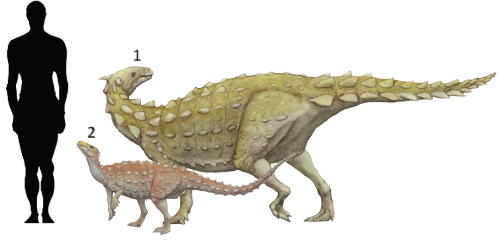Scutellosaurus

Scutellosaurus is an genus of thyreophoran ornithischian dinosaur that lived approximately 196 million years ago during the early part of the Jurassic Period in what is now Arizona, USA. It is classified in Thyreophora, the armoured dinosaurs; its closest relatives may have been Emausaurus and Scelidosaurus, another armored dinosaur which was mainly a quadrupedal dinosaur, unlike bipedal Scutellosaurus. It is one of the earliest representatives of the armored dinosaurs and the basalmost form discovered to date. Scutellosaurus was a small, lighly-built, ground-dwelling, herbivore, that could grow up to an estimated 1.2 m (3.9 ft) long.

The holotype specimen of Scutellosaurus lawleri (MNA V175) was recovered at the West Moenkopi Plateau locality in the Silty Facies Member of the Kayenta Formation, in Coconino County, Arizona on the land of the Navajo Nation. The specimen was discovered and collected by David Lawler in red claystone sediments that were deposited during the Sinemurian stage of the Jurassic period, approximately 196 million years ago.
Scutellosaurus is one of the earliest representatives of the armored dinosaurs (the thyreophorans) that would later include giants as Stegosaurus and Ankylosaurus. However, compared to some of its later relatives, Scutellosaurus was small and lightly armored. Along its back and extending onto the base of the tail were rows of small bony “shields” embedded in the skin. Some of these shields were flat, while others were pitched, like little roofs. The largest shields formed two rows that ran along the middle of the back.
Spread across the back, the shields formed a protective armored layer that would have defended the animal from attacks by such meat-eating dinosaurs as Dilophosaurus, with which it shared its early Jurassic world. Scutellosaurus would also have been reasonably fleet of foot and therefore able to escape predators by weaving its way through tangled undergrowth.

Scutellosaurus was lightly built, and was probably capable of walking on its hind legs. It had an unusually long tail, possibly to provide a counterbalance against the weight of the armored body. It was around 1.2 metres (3.9 ft) long, 50 centimetres (20 in) tall at the hips, and weighed 10 kilograms (22 lb). The fossil evidence includes several partial skeletons recovered from Arizona by the Museum of Northern Arizona and the University of California Museum of Paleontology, although the skull is poorly known from these specimens. There were several hundred osteoderms running along its neck to its back and as far down as its tail. These formed parallel rows, with as many as five rows on each side. It also had double rows of osteoderms, or external plates, running neck to tail. Some of these shields were flat, while others were pitted.








